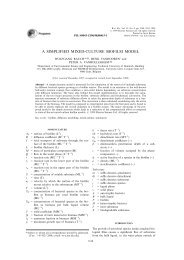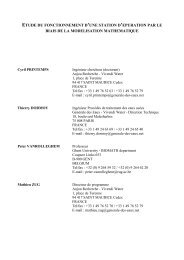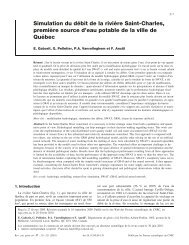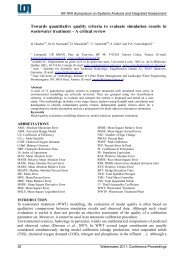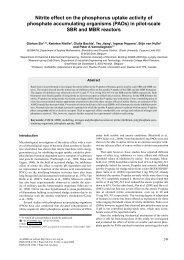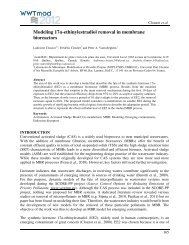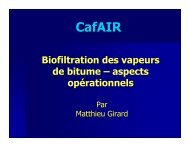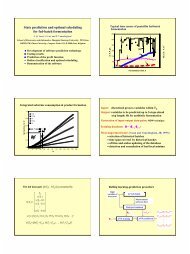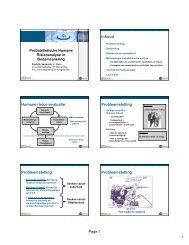Optimal control of the penicillin G fed-batch fermentation: An ...
Optimal control of the penicillin G fed-batch fermentation: An ...
Optimal control of the penicillin G fed-batch fermentation: An ...
Create successful ePaper yourself
Turn your PDF publications into a flip-book with our unique Google optimized e-Paper software.
PENICILLIN G FED-BATCH FERMENTATION 31p in (4). For <strong>the</strong> <strong>control</strong> needed we refer to <strong>the</strong> optimal <strong>control</strong> results: in <strong>the</strong> case <strong>of</strong> anunbounded input and an unconstrained state vector <strong>the</strong> growth phase is a <strong>batch</strong> phase. Allsubstrate consumed for growth is added all at once at time t = 0 in order to obtain <strong>the</strong> highestpossible value <strong>of</strong> p. Note that for <strong>the</strong> original specific production rate (3) this results inmaximizing ?F also. In <strong>the</strong> case <strong>of</strong> a constraint on <strong>the</strong> input and/or <strong>the</strong> state some minormodifications are required.5.1.2. Production phase [tz, 131. During production we focus on <strong>the</strong> specific productionrate T.(0Original model. Equation (3) indicates that <strong>the</strong> lowest value <strong>of</strong> p which still guarantees<strong>the</strong> maximum value <strong>of</strong> ?r is p = pcrit. Note that this is equivalent to Cs = Cs,crit, so <strong>the</strong><strong>control</strong> during production is <strong>of</strong> <strong>the</strong> form(ii)maintaining Cs and thus p at <strong>the</strong>ir critical values. This choice can also be motivated from<strong>the</strong> analysis <strong>of</strong> <strong>the</strong> optimal <strong>control</strong> result (see Figure4). As a consequence, <strong>the</strong>conjunction point t2 <strong>of</strong> growth and production follows from <strong>the</strong> condition:Cs(tz) = Cs.crit or p(f2) = b ritThe <strong>control</strong> (20) is stopped at t = t3 when all substrate is used (see (9) and (10)). As in<strong>the</strong> optimal case, <strong>the</strong> final <strong>batch</strong> phase [t3, tf] is stopped when dP/dt = 0. Note that <strong>the</strong>complete suboptimal <strong>control</strong> is obtained in closed loop for a given initial substrateamount SO. As a result, <strong>the</strong> optimization problem is reduced to <strong>the</strong> one-dimensionaloptimization <strong>of</strong> SO.Modi<strong>fed</strong> model. For values <strong>of</strong> B in <strong>the</strong> interval 0 < B < pcrit it is less clear how todetermine a heuristic <strong>control</strong> during production, since <strong>the</strong> specific production rate ?F in(12) no longer has a corner point. However, we will verify that keeping Cs and thus pconstant using a <strong>control</strong> <strong>of</strong> <strong>the</strong> form (20) is an appropriate choice for this case also. Theswitch from growth to production can be determined as follows. As a first guess we canstill switch on Cs = and thus p = brit. However, we know from Section 4 andFigure 7 that this guess is only appropriate for B near zero. For B near pcrit we willsimply optimize <strong>the</strong> switch time tz. As in <strong>the</strong> optimal <strong>control</strong> case, we obtain a twodimensional Optimization <strong>of</strong> SO and 12.As a ma<strong>the</strong>matical justijcation, it follows immediately from Theorem 1 that <strong>the</strong> suboptimal<strong>control</strong> pr<strong>of</strong>ile for <strong>the</strong> original model reduces to <strong>the</strong> optimal pr<strong>of</strong>ile if (and only if) B = 0 andkh= 0.Before giving some simulation results, some advantages <strong>of</strong> <strong>the</strong>se suboptimal pr<strong>of</strong>iles arementioned. It is well known that putting an optimal <strong>control</strong> into practice may be hamperedby a lot <strong>of</strong> problems. Since optimal <strong>control</strong> is a very model-sensitive technique, a feedforwardwill not generate <strong>the</strong> predicted simulation results. As long as a sufficiently accurate model for<strong>the</strong> <strong>penicillin</strong> <strong>fermentation</strong> is not available, <strong>the</strong> determined optimal <strong>control</strong> pr<strong>of</strong>iles can be usedonly to obtain a greater qualitative insight to <strong>the</strong> process.On <strong>the</strong> o<strong>the</strong>r hand, <strong>the</strong> suboptimal pr<strong>of</strong>iles we present here are <strong>the</strong> translation <strong>of</strong> a morerealistic <strong>control</strong> objective, namely setpoint <strong>control</strong>, for which even adaptive <strong>control</strong> algorithmscan be developed. It is illustrated in References 3 and 4 that we could keep <strong>the</strong> specific growthrate p constant without <strong>the</strong> knowledge <strong>of</strong> an exact analytic expression for it, so <strong>the</strong> <strong>control</strong>ler



